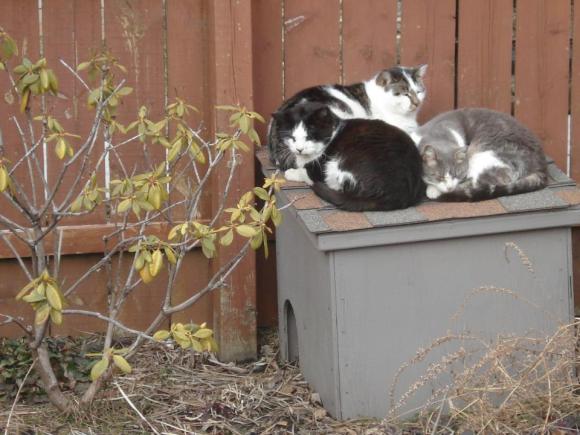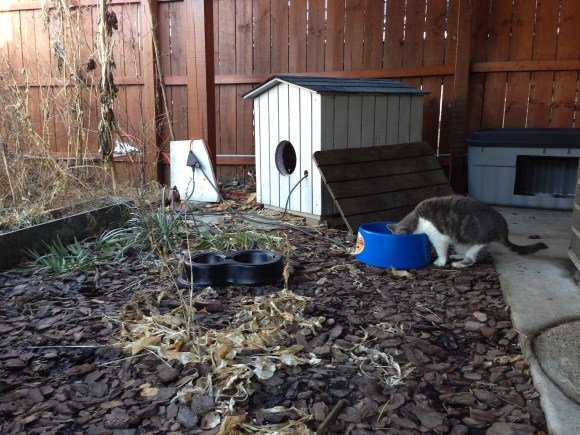This orange tabby cat, named Wolf Blitzer, aka Wolfie, has the kind of story that shows we are all doing the best we can with the information we have at the time. There is an outdoor cat overpopulation crisis and when you are doing TNR, you are preventing more cats from being born outside to suffer. In the meantime, some of the cats already outside like Wolfie are suffering. Every animal rescuer beats themselves up because we don’t always have the answers until the outcome, although we try. There is no blame here, although we blame ourselves constantly.
Wolfie’s story is also why I advocate that people trap their own cats for TNR – if they can. A cat colony caretaker knows their cats the best, and can observe any changes accordingly. This is not always possible, of course.
His story is also why I do TNR here only on the northwest side of Chicago, reasonably close to me. I will help the feeders and caretakers near me who cannot do the TNR on their own because they may be physically or financially unable to. ALL of Chicago has a lot of cats outside, not just certain areas. I believe in targeted trapping to reduce the numbers of cats in an area, and then take on the responsibility of continuing cat colony management as new cats show up to be TNR’d, and the existing cats require continued vet care as they get sick and injured. That has been more than enough to keep me more than busy with TNR here in my area since 2004. I am only able to do this because I am constantly talking to my neighbors about cats and working with them, whether they are feeders, caretakers, animal rescuers, or concerned citizens who also want to live in a community that doesn’t have animals dying and suffering outside in their yards. Sometimes these neighbors are also hoarders, or the kind of people that dump animals outside, or animal breeders, and I’ll still try to work with them. TNR is a community effort – you are not going to get better help elsewhere. Whenever I get requests from other areas, I urge people to knock on doors and get help directly from their own neighbors. They will most likely also find other cats and colonies, and then can do the TNReturn and rescue there as well.
OK, I’ll go on to Wolfie’s story, it just had me thinking, as it tied into so much of what happened these past few years with me and other people wanting me to help them with their animals. Wolfie showed up in one of Jennie’s colonies last spring. Jennie currently cares for 26-28 TNR’d cats outside in West Humboldt Park. Another 60-80+ cats from her area were moved into adoption, sanctuary or other locations since 2011 with the help of a no-kill shelter and their volunteers. I first met her then when I helped trap a few times in her area as a volunteer. She currently also has 10 rescued cats, one bird, one turtle and a dog in her home. She is overwhelmed, physically and financially unable to fully vet and feed all of the outdoor cats all of the time. With your help and donations this year, I’ve been delivering cat food to her, and I’ve vetted three of her colony cats so far: Mooksie, Gorgeous George, and Wolfie.
Wolfie showed up in her colony, fairly friendly last spring. A shelter staff person trapped him for her, TNR’d him at their clinic, and returned him outside. Wolfie was on their radar for admission, but could not be admitted right away. During his TNR, the clinic noted he was injured. Jennie never received that paperwork, so she did not know about his injuries. This was just something that happened because again, Wolfie was trapped by someone who was not directly observing the colony themselves, and who was trapping a lot of cats in a lot of colonies. Jennie blames herself bitterly for this. I understand why she does, I would be the same way, but again, this was no one’s fault. It just sucks overall.
After awhile, Jennie saw that Wolfie would show up at one of her feeding stations covered in diarrhea. By this time it was summer, June, and I agreed to take him to my vet. Since he was able to be handled, she put him into a carrier instead of a trap. That day I was also taking two other cats for vetting from two other colonies. Normally I treat all cats from outside initially as ferals, no matter their temperament, but he was so sweet and friendly in the carrier. He reached for me, meowed, and clearly wanted attention.

Delivering him in a carrier was a possible mistake, but I had no idea at the time. He was so cute and friendly! Had he been brought in a trap, he would’ve been sedated and examined as a feral. Maybe then they would have noticed more of his condition, rather than being treated as an outdoor friendly cat with diarrhea, which we all assumed was caused from parasites, a common problem. Remember, we didn’t know about his internal injuries yet.
I picked up Wolfie and the other two cats after their vetting that day and dropped them all off to their three different caretakers. Since the vet was in the suburbs, basically I was in the car all day. The cats were stressed from that and their vet visit. Wolfie had a blood exam, was cleaned, and had been diagnosed with possible inflammatory bowel disease. He was sent home with meds.

A few days later I learned from the vet that during his exam and clean-up, Wolfie bit a vet tech there which sent her to the hospital. As a result, they no longer treat feral cats to this day, even though Wolfie was not a feral cat. No exceptions. I don’t blame them for this either. I offered to talk to them about feral cats, and all that we face working with them, along with all that they face working with them, but this was not the avenue they wanted to take. It is one of those things that happens that again sucks. There’s no other word for it.
Meanwhile, Jennie decided to foster Wolfie and care for him. She asked the shelter again for admission. Their vet saw him once or twice, and we then learned about the internal injuries, caused by blunt trauma, that they had discovered during his initial TNR. Had we known about these injuries, I would have told my vet about them, and possibly have avoided the whole biting mess. He most likely bit that vet tech because of the extreme pain he must have been in. Again, we all do the best we can with the information that we have at the time. Hindsight is always 20/20. Blah blah blah. You know what I mean. Again, it SUCKS.
The shelter ultimately refused admission for Wolfie based on their exam. Jennie managed to get him into another shelter called C.A.R.E. last month. Coincidentally, he was admitted with another one of her cats, Gorgeous George, that I vetted from her colonies.
They took Wolfie to their vet, who determined he had nerve and spinal damage, most likely from being hit by a car, causing the slow failure of his bladder and colon ever since. His injuries and condition were only getting worse. They humanely euthanized Wolfie last week.
RIP Wolfie. We’re thankful that despite everything that happened, we were able to prevent you from slowly dying alone on the street. We’ll continue doing everything we can to help the outdoor cats.


































































































How can I skip the stories of individual cats and just find how to find info on the blog: healthcare suggestions, housing, waste collection and disposal, etc. I’m sure you and readers have ideas to share. I can’t bear to read another teary story about old cats or kittens or…I have enough of those of my own. I suspect others who maintain small colonies have as well. Don’t mean to be petty but I really need ideas that d purport our efforts more than warm fuzziness m I’m al tee easy committed.
By the way, those open cell political signs candidates leave all over the place make pretty good insulation. I liked the article on use of tubs. I have used all sorts of containers but never thought to cut holes in tubs.